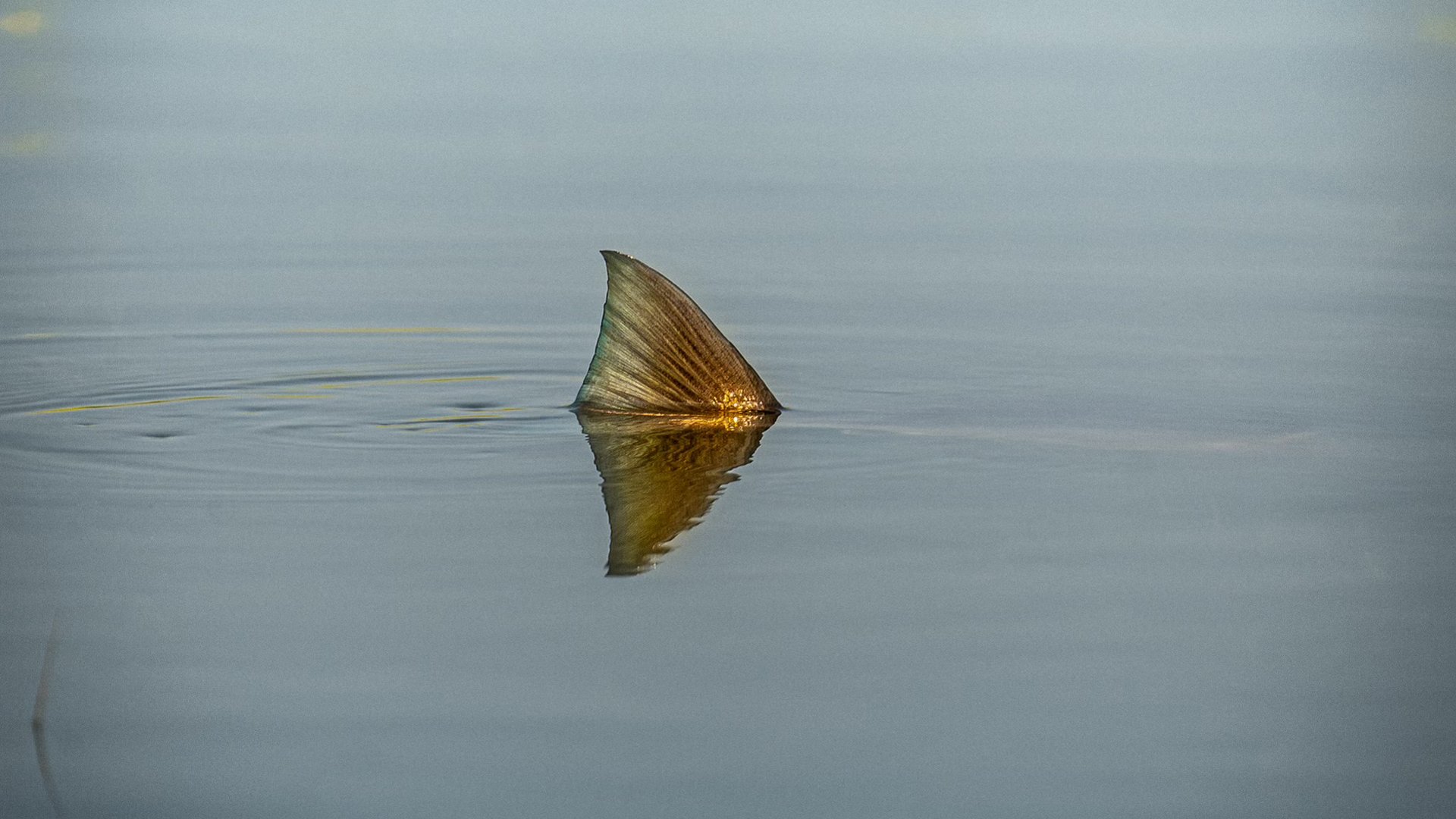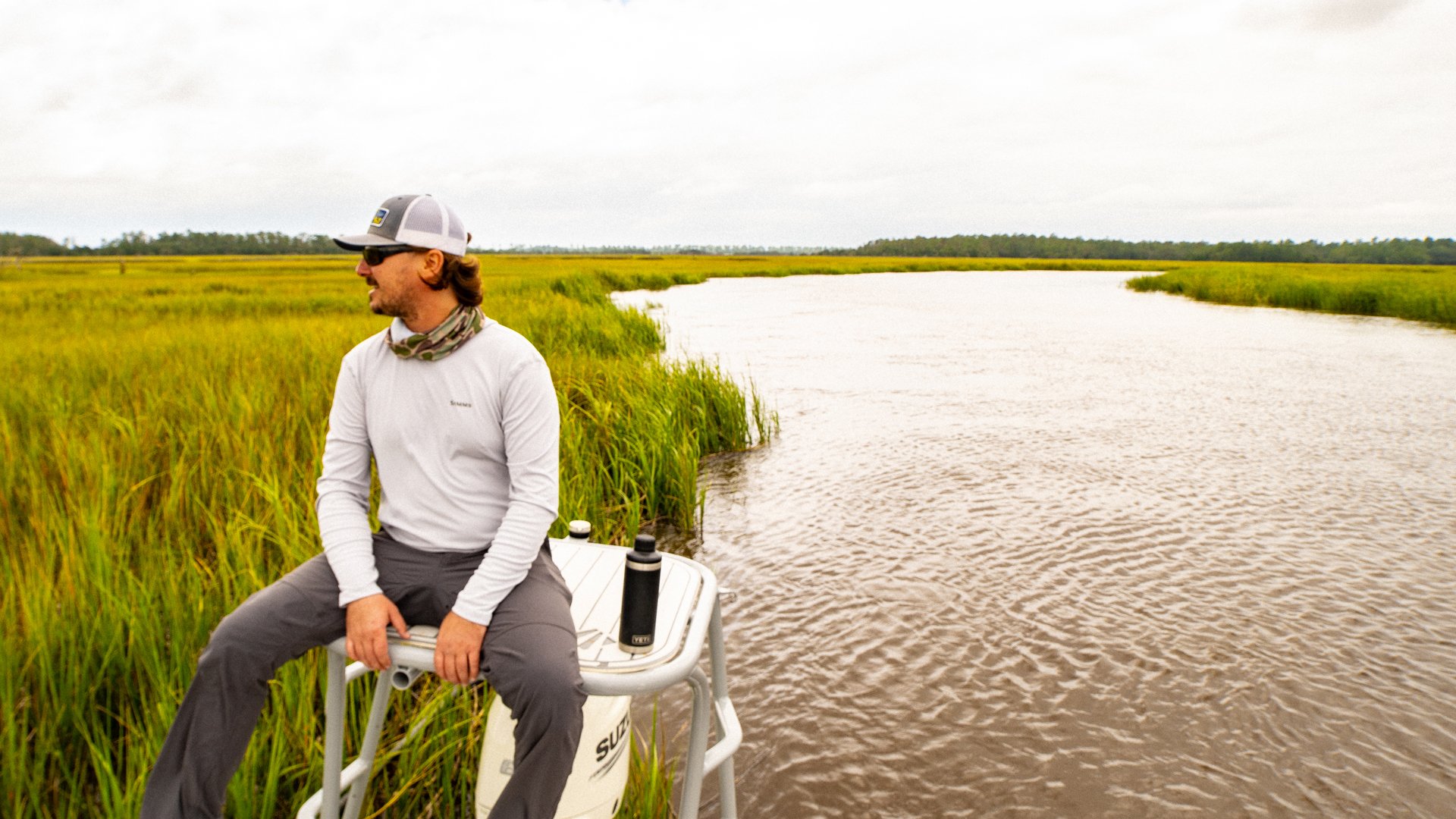
South Carolina Lowcountry Fly Fishing Trips
Fly fish Beaufort, Hilton Head, Fripp Island, and Edisto, SC year-round. Anglers of all abilities welcome.
Fly fishing the South Carolina Lowcountry is an unforgettable experience that combines southern hospitality with a laid back coastal culture in a picturesque setting that is home to some of the greatest fly fishing in the world for redfish, tarpon, cobia, jack crevalle, tripletail, albies, and more.
Fly fishing the Lowcountry is a hunt, where sight fishing is the preferred method. While actively looking for fish in likely areas, the guide poles and/or trolls quietly, visually (and sometimes audibly) inspecting for the telltale signs of fish. Once located, it is up to the angler to make a shot and present the fly in a controlled manner. When everything is done correctly, and with a little luck, the rewards are worth the effort. Most fly anglers understand that saltwater fly fishing is not normally a numbers game, and that fooling a fish with a fly, and watching the event unfold is the main appeal.

The Lowcountry
Beaufort, SC is a premiere fly fishing destination for those looking for a true Lowcountry experience. Set in the heart of the Lowcountry, Beaufort is far enough from the tourist centers of its neighbors and offers a local experience catering to anglers looking for easy access to some of the best fly fishing in the area.
Beaufort, SC
With over 3,000 acres of marine sanctuary, Fripp Island is a barrier island in the Lowcountry that is known for its limited development and natural beauty. The island attracts those looking for a laid back Lowcountry experience enjoying coastal South Carolina beaches, food, and of course great fly fishing.
Fripp Island, SC
Hilton Head Island draws visitors from around the world for a myriad of reasons; the beaches, golf, tennis, food, and of course fishing. Those wishing to enjoy the wild side of Hilton Head will not be disappointed in the decision to book a day or two on the water while in the area with family, friends, and/or business colleagues.
Hilton Head, SC
Edisto is located in the heart of the Lowcountry and represents some of the last remaining parts of old South Carolina. One of the areas largest barrier islands, Edisto is dotted with some of the oldest family plantations in the area. For anglers looking to escape the pace of Charleston, Edisto Island is a great place to start.
Edisto, SC
When Is The Best Time To Fly Fish The Lowcountry?
The SC Lowcountry is a year-round fishery with seasonal highlights appropriate for anglers of all abilities.
Summer Fly Fishing In The Lowcountry
The summer months (June-Sept) offer what most fly anglers come to the Lowcountry for, flood tide redfishing. Warm stable conditions and frequent high tides bring schools of redfish inshore to gorge on fiddler crabs while on the flats. Redfish can be found in less than a foot of water cruising, backing, waking, and tailing while looking for an easy meal. More often than not, these reds have their guard down as they are focused on feeding before the tide falls out. The spartina grass flats of the Lowcountry make it tricky to properly present a fly, but also give anglers the ability to get close to tailing fish either in the boat or on foot, making summer redfishing a great pursuit for fly anglers of all abilities.
Another highlight of the summer are the tarpon that show up in the Lowcountry, nearing the end of their northward migration. Tarpon can be found in the deeper rivers and channels throughout the Lowcountry. Fly anglers most frequently target them rolling, but tarpon can occasionally be found laying up and cruising the surface of our backcountry basins. Juvenile tarpon can also be caught in the summer months in some of the ponds and lagoons around the Lowcountry.
Schools of big jack crevalle can be found during the summer destroying schools of bait in the backcountry basins as well as the nearshore waters off the coast. These jacks aren’t picky and will eat anything in their paths that remotely resembles a baitfish, shrimp, or crab. Pound for pound jacks are the hardest fighters in the marsh and will test an angler’s tackle, as well as stamina.
Fall Fly Fishing In The Lowcountry
As the weather cools and the sun gets lower in the sky, it triggers fish in the area to school up and feed hard in preparation for the winter. During October through early December, baitfish congregate, and some make their way south to warmer waters. During this time redfish have the tendency to form large schools and spend time in the South Carolina backcountry hunting for pods of baitfish. Fall tides in the Lowcountry are generally lower than during the summer, and the north winds tend to keep the water even lower. Although flood tide events exist, fall fly fishing for redfish is mostly a low tide game where schools of fish are targeted in the creeks, along shorelines, and on mud flats while soaking up the sun to keep warm.
Just offshore, schools of albies are making their journey southward, following the bait through the Lowcountry and providing anglers with an exciting experience. Fly fishing for albies is pure chaos where schools of feeding fish are chased down, sometimes at high speed. Once in range, an angler usually has to only get their fly amongst the feeding frenzy to get bit. Albies are fast, and the chaos of the bite isn’t over until the fly line is safely off the deck, without tangling around anything or anyone, and on the reel.
Winter Fly Fishing In The Lowcountry
By mid-December winter has usually set into the Lowcountry and the water temps are the coldest of the year. The winter is our off-season, but great fishing can be found. The windows of opportunity are generally smaller than during warmer months. During these more stable winter weather windows, anglers attention is usually focused inshore for redfish and trout where schools of both can be targeted in the shallows. Redfish can still be sight fished on low tides as well as on the occasional flood tide. Trout can be caught blind casting deeper holes and pockets. Occasionally shots at black drum, sheepshead, and even flounder can be had during the winter months
Spring Fly Fishing In The Lowcountry
Warming spring weather brings new life to the Lowcountry. The leaves on the trees start to reappear about the same time the spartina grass begins to green up. The baitfish, shrimp, and crabs return to the shallows, and redfish start to tail on the grass flats more frequently. Anglers targeting them might get lucky enough to hear a distant turkey gobbling on a calm morning.
Usually beginning in April mature cobia show up to feed on the returning bait and spawn in the Lowcountry basins. These cobia can exceed sixty pounds and can be targeted near the surface finning and waking while doing their thing. Fly fishing the Lowcountry for cobia is not the most technical type of fly fishing as most cobia will grab a natural looking fly that is placed in their field of view.
During the same time, tripletail show up in the area. Attracted to structure, tripletail are ambush predators who regularly take flies in deep water but can also be targeted on the flats during flood tides. Fly fishing for tripletail is not the most difficult thing to do with a fly rod, and tripletail make great targets for those newer to saltwater fly fishing.
Lowcountry Fly Fishing Charter Details
Capt. Nicholas Boyd offers full day, three-quarter day and half day Lowcountry fly fishing trips out of Beaufort, Hilton Head, Fripp Island, and Edisto, SC. Multiple boats are available for groups of more than 2 people. Contact us for current rates and availability. All trips include tackle/flies, fuel costs, launch fees, and a cooler with water and ice.
Payments And Deposits
Cash, Check or Venmo.
Credit cards through Venmo (additional service charges may apply)
$200 per day per boat deposit for all trips
Venmo or mail deposits to:
Nicholas Boyd
1611 Colleton Drive
Beaufort, SC 29906
What To Bring
Polarized sunglasses (amber or copper lenses preferred)
Hat and any needed sun protection
8/9, & 10 wt. rods (if own gear is preferred)
Quick drying clothing system
Rain gear, jackets and pants
Shoes with non-marking soles
A bubbly positive attitude













